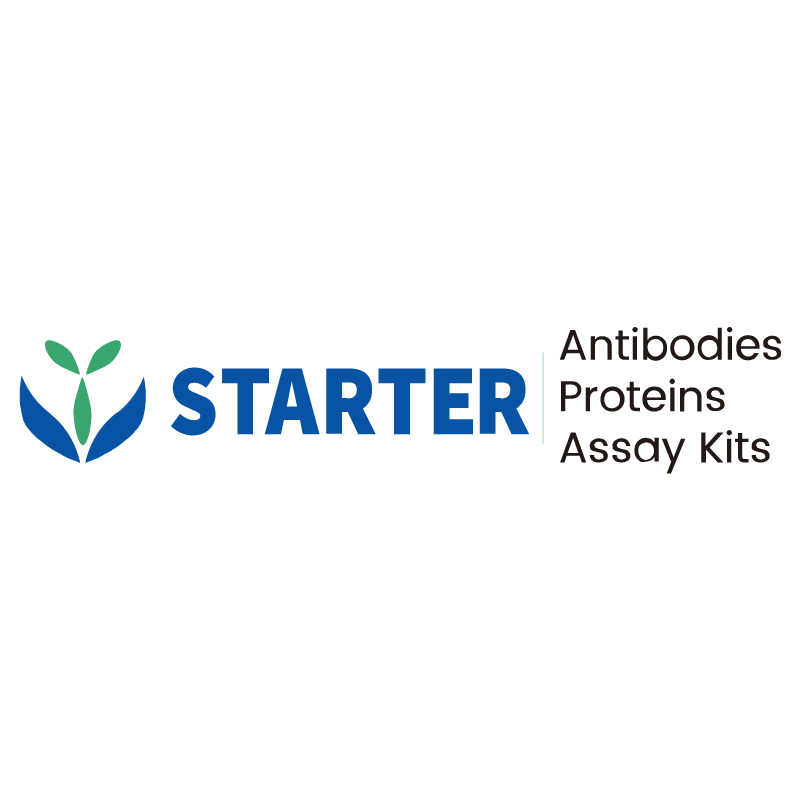WB result of PKA C-α Recombinant Rabbit mAb
Primary antibody: PKA C-α Recombinant Rabbit mAb at 1/1000 dilution
Lane 1: HeLa whole cell lysate 20 µg
Lane 2: 293T whole cell lysate 20 µg
Lane 3: MCF7 whole cell lysate 20 µg
Secondary antibody: Goat Anti-rabbit IgG, (H+L), HRP conjugated at 1/10000 dilution
Predicted MW: 41 kDa
Observed MW: 39 kDa
Product Details
Product Details
Product Specification
| Host | Rabbit |
| Antigen | PKA C-α |
| Synonyms | cAMP-dependent protein kinase catalytic subunit alpha; PKA C-alpha; PKACA; PRKACA |
| Immunogen | Synthetic Peptide |
| Location | Cytoplasm, Nucleus, Cell membrane |
| Accession | P17612 |
| Clone Number | S-2564-5 |
| Antibody Type | Recombinant mAb |
| Isotype | IgG |
| Application | WB, IHC-P |
| Reactivity | Hu, Ms, Rt, Mk |
| Positive Sample | HeLa, 293T, MCF7, NIH/3T3, mouse brain, mouse kidney, C6, rat brain, rat kidney |
| Predicted Reactivity | Bv, Dg, Hm, Sh |
| Purification | Protein A |
| Concentration | 0.5 mg/ml |
| Conjugation | Unconjugated |
| Physical Appearance | Liquid |
| Storage Buffer | PBS, 40% Glycerol, 0.05% BSA, 0.03% Proclin 300 |
| Stability & Storage | 12 months from date of receipt / reconstitution, -20 °C as supplied |
Dilution
| application | dilution | species |
| WB | 1:1000-1:5000 | Hu, Ms, Rt, Mk |
| IHC-P | 1:1000 | Hu, Ms, Rt |
Background
PKA C-α protein, fully known as cAMP-dependent protein kinase A catalytic subunit alpha, is a crucial signal transduction molecule within cells, often regarded as one of the fundamental "molecular switches" of life. As the core catalytic component of the PKA holoenzyme, it exists in an inactive state bound to regulatory subunits. When the levels of the second messenger cAMP rise, cAMP binds to the regulatory subunits, causing their dissociation from the catalytic subunit and thereby activating PKA C-α. Once activated, PKA C-α exerts its function by transferring a phosphate group from ATP to specific serine or threonine residues on its target substrate proteins, a process known as reversible phosphorylation. This mechanism precisely regulates a vast array of core physiological functions, including glycogen metabolism, lipid synthesis, gene transcription, cell proliferation and differentiation, learning and memory, and heart rhythm. Dysregulation of its activity or expression is closely associated with various human diseases, such as cancer, heart disease, metabolic disorders, and brain dysfunction.
Picture
Picture
Western Blot
WB result of PKA C-α Recombinant Rabbit mAb
Primary antibody: PKA C-α Recombinant Rabbit mAb at 1/1000 dilution
Lane 1: NIH/3T3 whole cell lysate 20 µg
Lane 2: mouse brain lysate 20 µg
Lane 3: mouse kidney lysate 20 µg
Secondary antibody: Goat Anti-rabbit IgG, (H+L), HRP conjugated at 1/10000 dilution
Predicted MW: 41 kDa
Observed MW: 39 kDa
WB result of PKA C-α Recombinant Rabbit mAb
Primary antibody: PKA C-α Recombinant Rabbit mAb at 1/1000 dilution
Lane 1: C6 whole cell lysate 20 µg
Lane 2: rat brain lysate 20 µg
Lane 3: rat kidney lysate 20 µg
Secondary antibody: Goat Anti-rabbit IgG, (H+L), HRP conjugated at 1/10000 dilution
Predicted MW: 41 kDa
Observed MW: 39 kDa
WB result of PKA C-α Recombinant Rabbit mAb
Primary antibody: PKA C-α Recombinant Rabbit mAb at 1/1000 dilution
Lane 1: COS-7 whole cell lysate 20 µg
Secondary antibody: Goat Anti-rabbit IgG, (H+L), HRP conjugated at 1/10000 dilution
Predicted MW: 41 kDa
Observed MW: 39 kDa
Immunohistochemistry
IHC shows positive staining in paraffin-embedded human colon. Anti- PKA C-α antibody was used at 1/1000 dilution, followed by a HRP Polymer for Mouse & Rabbit IgG (ready to use). Counterstained with hematoxylin. Heat mediated antigen retrieval with Tris/EDTA buffer pH9.0 was performed before commencing with IHC staining protocol.
IHC shows positive staining in paraffin-embedded human cardiac muscle. Anti- PKA C-α antibody was used at 1/1000 dilution, followed by a HRP Polymer for Mouse & Rabbit IgG (ready to use). Counterstained with hematoxylin. Heat mediated antigen retrieval with Tris/EDTA buffer pH9.0 was performed before commencing with IHC staining protocol.
IHC shows positive staining in paraffin-embedded human colon cancer. Anti- PKA C-α antibody was used at 1/1000 dilution, followed by a HRP Polymer for Mouse & Rabbit IgG (ready to use). Counterstained with hematoxylin. Heat mediated antigen retrieval with Tris/EDTA buffer pH9.0 was performed before commencing with IHC staining protocol.
IHC shows positive staining in paraffin-embedded human hepatocellular carcinoma. Anti- PKA C-α antibody was used at 1/1000 dilution, followed by a HRP Polymer for Mouse & Rabbit IgG (ready to use). Counterstained with hematoxylin. Heat mediated antigen retrieval with Tris/EDTA buffer pH9.0 was performed before commencing with IHC staining protocol.
IHC shows positive staining in paraffin-embedded mouse cerebral cortex. Anti- PKA C-α antibody was used at 1/1000 dilution, followed by a HRP Polymer for Mouse & Rabbit IgG (ready to use). Counterstained with hematoxylin. Heat mediated antigen retrieval with Tris/EDTA buffer pH9.0 was performed before commencing with IHC staining protocol.
IHC shows positive staining in paraffin-embedded rat cerebral cortex. Anti- PKA C-α antibody was used at 1/1000 dilution, followed by a HRP Polymer for Mouse & Rabbit IgG (ready to use). Counterstained with hematoxylin. Heat mediated antigen retrieval with Tris/EDTA buffer pH9.0 was performed before commencing with IHC staining protocol.


